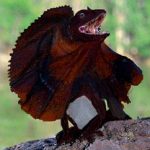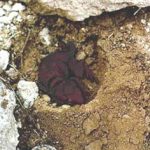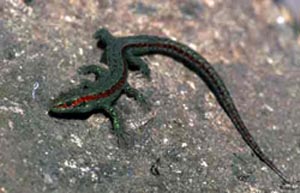These lizards are common predators and scavengers on the Plains of Tekara. They are found in packs of up to a dozen animals. They are renowned for their ability to strip the carcass of a dead animal in a matter of hours, often aggressively defending the feast from larger scavengers. Kenkara are also known to be capable problem solvers and thus are difficult to trap. They possess an opposable digit on all six feet.
The average adult Kenkara is 6-7 kg in mass, and measures 50-70 cm in total length of which about one third is tail. Their scales range from dull red through black in colour, with a pale grey underbelly. The males of the species have a neck frill of brighter colours that is flared to scare off larger scavengers. The male’s frill is also used in mate selection, and displayed repeatedly during mating.
Females will lay just shy of a dozen eggs and brood them in a shallow scraped hollow. Once the eggs hatch the female leaves to join her group. Her brood are left to fend for themselves, and will often be found later as an adult pack.



